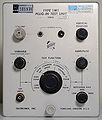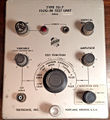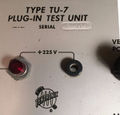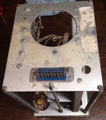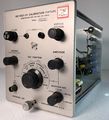1M1: Difference between revisions
mNo edit summary |
(duplicate docs removed; BAMA copy = 070-407;) |
||
| Line 10: | Line 10: | ||
|designers= | |designers= | ||
|manuals= | |manuals= | ||
* [[Media:070- | * [[Media:070-407.pdf|Tektronix TU-7 Manual]] (070-407; rough scan, OCR) | ||
* [[Media:070-0407-01.pdf|070-0407-01 Tektronix 067-0521-00 Manual]] (070-0407-01; OCR) | |||
* [[Media:070-0407-02.pdf|070-0407-02 Tektronix 067-0521-01 Manual]] (070-0407-02; OCR) | |||
* [[Media: | |||
* [[Media: | |||
* [[Media:Tek tu-7 irb.pdf|Tektronix TU-7 Instrument Reference Book]] (OCR) | * [[Media:Tek tu-7 irb.pdf|Tektronix TU-7 Instrument Reference Book]] (OCR) | ||
* [[Media:Tek 067-0521-00 fcp july 1969.pdf|Tektronix 067-0521-00 Factory Calibration Procedure, July 1969]] | * [[Media:Tek 067-0521-00 fcp july 1969.pdf|Tektronix 067-0521-00 Factory Calibration Procedure, July 1969]] | ||
| Line 28: | Line 24: | ||
(500-series mainframes are designed to have 10 div/Volt response to differential signals from the plug-in, and zero response to common-mode signals.) | (500-series mainframes are designed to have 10 div/Volt response to differential signals from the plug-in, and zero response to common-mode signals.) | ||
It contains a transistor multivibrator whose output is sharpened through Tek-made Gallium-Arsenide diodes (later production used silicon), a dual-trace circuit using [[12AT7]] and [[6AL5]] tubes, and various load resistors. | It contains a transistor multivibrator whose output is sharpened through Tek-made Gallium-Arsenide diodes (later production used silicon), a dual-trace circuit using [[12AT7]] and [[6AL5]] tubes, and various load resistors. It does not have the Type P's short operating life because it does not use a [[mercury switch]]. | ||
It does not have the Type P's short operating life because it does not use a [[mercury switch]]. | |||
This instrument went through several names. At its [[introduced in 1964|1964]] introduction, it was the '''TU-7'''. | This instrument went through several names. At its [[introduced in 1964|1964]] introduction, it was the '''TU-7'''. | ||
Some early Tek-internal instruments for design, manufacturing, and calibration had TU (Test Unit) nomenclature. | Some early Tek-internal instruments for design, manufacturing, and calibration had TU (Test Unit) nomenclature. | ||
(Other examples include the [[TU-75B]] Variac | (Other examples include the [[TU-75B]] Variac, and the [[TU-50]] sine/square/pulse generator.) | ||
In 1965, it was renamed '''Type 1M1''' to fit into the letter-series nomenclature like its predecessor. | In 1965, it was renamed '''Type 1M1''' to fit into the letter-series nomenclature like its predecessor. | ||
Revision as of 09:06, 26 January 2023
The Tektronix TU-7/1M1/067-0521-00 is a letter series plug-in used for calibrating 500-series scopes.
It is a multifunction replacement for the Type P Pulser, the TU-2 Test Load, and the EP-53 Gain Set Adaptor.
It is used for calibrating the mainframe's step response and gain, checking dual-trace operation, common mode rejection, and power supply regulation.
(500-series mainframes are designed to have 10 div/Volt response to differential signals from the plug-in, and zero response to common-mode signals.)
It contains a transistor multivibrator whose output is sharpened through Tek-made Gallium-Arsenide diodes (later production used silicon), a dual-trace circuit using 12AT7 and 6AL5 tubes, and various load resistors. It does not have the Type P's short operating life because it does not use a mercury switch.
This instrument went through several names. At its 1964 introduction, it was the TU-7. Some early Tek-internal instruments for design, manufacturing, and calibration had TU (Test Unit) nomenclature. (Other examples include the TU-75B Variac, and the TU-50 sine/square/pulse generator.)
In 1965, it was renamed Type 1M1 to fit into the letter-series nomenclature like its predecessor. Later still, the 067- calibration fixture naming system took hold and it was rechristened 067-0521-00.
The instrument was also revised once - more pulse frequencies - and the name upgraded to 067-0521-01.
It does not appear - under any name - in any Tek catalog, but the 1964 catalog does list a cousin: Type 10/11M1, for the Type 647 scope.
Links
- 067-0521-01 @ radiomuseum.org
Pictures
-
-
-
-
-
TU-7 variant with five repetition rates
-
TU-7 variant with five repetition rates
-
TU-7 variant with five repetition rates
-
TU-7 variant with five repetition rates
-
TU-7 variant with five repetition rates
-
067-0521-01 Front
-
067-0521-01 LHS
-
067-0521-01 RHS
-
067-0521-01 Top
-
067-0521-01 Bottom
-
067-0521-01 Schottky Diodes (pulse generator)
-
067-0521-01 Vertical amp step response test on a 547
-
067-0521-01 Chopped trace test signal


